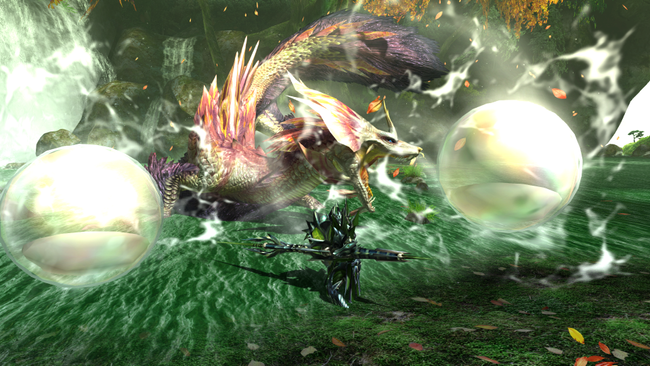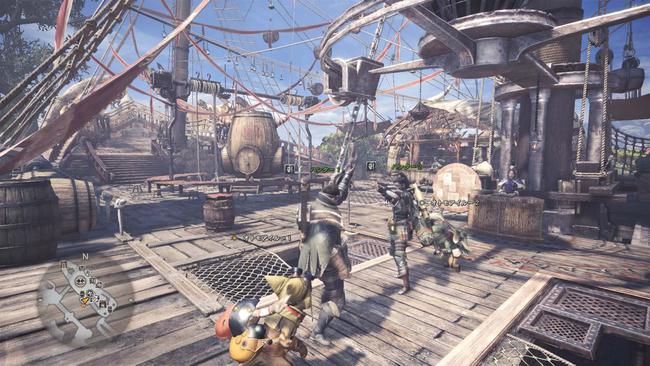
Monster Hunter Generations Ultimate versus Monster Hunter: World - All You Need To Know
It's a little hard to believe after so much silence on Capcom's end, but Monster Hunter XX is finally coming westward as Monster Hunter Generations Ultimate, exclusively on Nintendo Switch. We've already covered the game in the past, closer to its Japanese release, but now with the title getting translated hot on the heels of Monster Hunter: World's, well, monstrous success - naturally some new fans to the series might be curious about this decidedly more traditional Monster Hunter affair. In fact, even if you're a big fan of Monster Hunter: World, it might be prudent for you to get a better idea for the various differences between the two games before deciding to give this one a shot. Monster Hunter: World brought a large suite of changes to the series, and it's worth noting that Monster Hunter Generations Ultimate technically came out in Japan before World shook up the series.
Roots on the Nintendo 3DS
It might be a little confusing, considering Monster Hunter Generations Ultimate is releasing exclusively for Nintendo Switch over here in the west; but the game itself actually started life as a Nintendo 3DS game in Japan. In fact, Monster Hunter Generations Ultimate is the "G-rank" version of Monster Hunter Generations, which released nearly 2 years ago on the 3DS. To compound matters further, it was part of the "4th generation" of Monster Hunter titles, which means that it shares much of its DNA - monsters, areas, and what-have-you - with Monster Hunter 4, which itself released in Japan almost 5 years ago in 2013.
While Monster Hunter Generations Ultimate does include a host of Quality-of-Life changes compared to that original 4th generation title released half a decade ago, as well as much better visuals compared to the original Japanese 3DS release, those 3DS limitations are very much still in play. On the other hand, Monster Hunter: World axed loading zones, making maps seamless with nothing breaking up the action. As a result, in order to better balance the combat, it allowed players to move around while chugging down most potions and healing. Because maps became sprawling, scoutflies were introduced to keep hunters on the right track to monsters. If you started with Monster Hunter: World and haven't played an older Monster Hunter before; forget all of what I just said. Monster Hunter Generations Ultimate doesn't have any of that.

What isn't in Monster Hunter Generations Ultimate, and what it has over Monster Hunter: World
Monster Hunter Generations Ultimate expects a lot more from players than World does. Mining, catching bugs, and even sharpening a weapon all were things you could just do in World. Those same tasks require a pickaxe, a bug net, or even a supply of whetstones to accomplish in Generations Ultimate - all of which can, and will, break. If a monster runs away, you can't just open your map and find them - you'll have to hit them with a paintball first, or failing that, chug a psychoserum to find out which zone of the map the enemy has fled to. Once you've found them, you can't just teleport to the nearest base camp; those don't exist in the older games. Loading zones break up the action, letting you both take a quick breather from a fight to heal while also making areas feel less unified than in World. While ledges and aerial attacks still exist, slopes and walls you can run up to vault off of do not: the radial menu is not a thing, and many weapon movesets are considerably more restricted compared to their counterparts in World.
If you've never played any other Monster Hunter, then going from World backwards might give you shell shock, as it's a lot to take in. However, while Monster Hunter Generations Ultimate might not be as accessible as World, it does have its own unique advantages: Hunting Arts, Hunting Styles, and the inclusion of both a higher tier of difficulty called G-rank and a much larger large monster roster for players to hunt. Hunting Arts are unique moves or items that can be used once a gauge fills up from attacking monsters, and can range from healing, a last-minute dodge, a counter, or other such moves. Hunting Styles are a bit more distinct - players can choose from up to 6 different Hunting Styles in Generations Ultimate, ranging from the default "Guild" style, to the powerful "Striker" style, the nimble "Adept" style, and even new ones like "Brave" style and "Alchemy" style.
Hunting Arts and Hunting Styles
These "Hunting Styles" fundamentally alter how hunters control, having a direct impact on both their weapons' movesets, and in some cases - how dodging or blocking works. Guild style is the standard, Adept allows you to counter a monster's attack if dodged at just the right time, Aerial allows you to hop off of monsters and deal combos while in the air. There's more, but the gist of it all is there - the new Brave Style and Alchemy style are new to Monster Hunter Generations Ultimate and were notably absent from the original 2016 3DS release. On the flipside, while Hunting Styles encompass an entire weapon's moveset, Hunting Arts are something else entirely. You can think of them as something like a special move from a fighting game, and they can come in both offensive and support varieties. Some Arts are locked to specific weapons while others are weapon agnostic, such as instant dodges or setting down something similar to the healing stakes from Monster Hunter: World.
Going back to the fighting game comparison, you'll have to build up a gauge for each Hunting Art by dealing damage. Special weapons crafted from Deviant monsters (more on that later) can build up these gauges faster. The number of Arts that you can equip depends on your hunting style - Guild style has 2 slots, while most other styles have 1. Striker has 3. Each Art has its own separate gauge, so if your Hunting Style permits more than one Hunting Art to be equipped then you can charge up more than 1 Art at a time. While players could activate Hunting Arts using the touchscreen on 3DS, they're activated using the dpad by default on Switch.

Deviant Monsters, and G rank
While Tempered Elder Dragons, Arch-Tempered Elder Dragons, and Kulve Taroth should be considered the end-game for Monster Hunter: World, Monster Hunter Generations Ultimate features an extra level of difficulty called G-rank, which unlocks after High Rank. However, even with the inclusion of G-rank, MHGU's endgame doesn't deviate too much from Monster Hunter Generation's. Deviant Monsters are essentially what happens when you take a monster's core theme, and take it to its logical conclusion. A Rathian that slings poison everywhere, a Rathalos whose fireballs become especially deadly, and more - while their movesets aren't incredibly different from base monsters, the ferocity at which they attack and the damage they deal are a massive upgrade comparatively.
Deviant Monster equipment can be especially powerful once maxed out, though this comes with the caveat that crafting and fully upgrading a full set of equipment out of each beast takes a rather large time commitment. Clearing a Deviant Monster hunt will give you 2 tickets for the level of the Deviant Monster you faced, and each piece of equipment and each subsequent upgrade requires two tickets of the equivalent level to craft. Just to make a base set and a weapon for one Deviant Monster takes 6 hunts against the same monster - then you have to hunt it 54 more times with increasing difficulty to gather enough tickets to fully upgrade a set. There are plenty of Deviant Monsters to choose from, but if you're dead set on making a complete set for a monster's gear - which you'll want due to powerful, sometimes exclusive armor skills - you'll be sinking dozens of hours into each set. Possibly near 100 hours if you want to attempt to make all of a Deviant Monsters weapons, too.
Online Connectivity and Portability
Ironically, in many ways, I'd have to give the edge out to Monster Hunter Generations Ultimate when it comes down to online functionality, compared to Monster Hunter: World. While there might not be any dedicated voice chat, at least when it comes to playing with your friends the whole experience is a lot smoother. In Monster Hunter: World, since both singleplayer and multiplayer progress were linked, players were shackled with confusing requirements around watching cutscenes before they could progress with their friends. With MHGU, everything is much simpler - singleplayer and multiplayer quests are separate. If you want to hunt something with a friend, as long as it's a multiplayer quest and you all meet the Hunter Rank requirement then you're good to go. Monster Hunter: World admittedly has some fun with online events like the various seasonal festivals, and Kulve Taroth, but actually playing through the campaign - a 60-90 hour affair - is a hassle if you want to play through it alongside your friends.
Of course, it's not just online play that's arguably more convenient on Switch, as Monster Hunter Generations Ultimate also supports local wireless multiplayer. If your friends are in the same room, you can hunt together. Speaking from experience, some of the most memorable hunts I've ever had in prior entries came as a result of random hunts with strangers during conventions. While this might be a moot point to those that plan to only play their Switch at home, the option of local multiplayer is certainly a massive plus for some - myself included.

Which Should You Buy?
With Monster Hunter: World finally hitting PC, and Monster Hunter Generations Ultimate releasing on Switch later this month - you might be asking yourself which one to buy, especially if you're new to the series. While I might shout from the hills for you to buy both, of course which game will be right for you comes down to personal preference and your preferred way of play over anything else. If you expect to play Monster Hunter in shorter play sessions, and having the option to play the game portably appeals to you - Monster Hunter Generations Ultimate might be the easy choice. Conversely, if you're aiming for a much more beginner friendly experience than Monster Hunter: World would be the best choice.
Where things get tricky is when it comes to things like multiplayer. Monster Hunter: World might be a pain to play through the story with your friends, but the endgame is probably a touch more enjoyable than Monster Hunter Generation Ultimate's. Regular DLC updates have continually enhanced what players can expect at the endgame, and have included plenty of reasons for players to continue checking back. Monster Hunter Generations Ultimate might have a beefier endgame out of the gate, but it's hard to recommend it considering how much of an endless grind hunting Deviant Monsters can feel like in the games later hours. Then consider that Monster Hunter: World will likely receive an expansion to bring in G-rank later down the line, even Monster Hunter Generation Ultimate's endgame won't be the beefier experience forever.
Regardless of my personal preferences, you can't really go wrong with either game. Even if previous Monster Hunter's might not be as beginner friendly compared to World, it's doubtless that the community is larger than ever before, and you can expect both the resources and support to help you break through that initial barrier all the same. There's never been a better time to be a Monster Hunter fan, so whichever games you choose you'll be sure to have a great time!